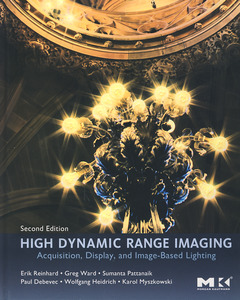Description
High Dynamic Range Imaging (2nd Ed.)
Acquisition, Display, and Image-Based Lighting
Authors: Reinhard Erik, Heidrich Wolfgang, Debevec Paul, Pattanaik Sumanta, Ward Greg, Myszkowski Karol
Language: English
Subjects for High Dynamic Range Imaging:
Keywords
digital image; image processing; tone reproduction; image capture; display devices; light; color
92.73 €
In Print (Delivery period: 14 days).
Add to cart672 p. · 19x23.3 cm · Hardback
Description
/li>Contents
/li>Readership
/li>Biography
/li>Comment
/li>
1. Introduction2. Light and Color3. High Dynamic Range Image Encodings4. HDR Video Encodings5. HDR Image Capture6. Display Devices and Printing Technologies7. Perception-Based Tone Reproduction8. Tone Reproduction Operators9. Inverse Tone Reproduction10. Visible Difference Predictors11. Image-Based Lighting
Wolfgang Heidrich is Associate Professor and Dolby Research Chair at the Department of Computer Science, University of British Columbia.
Paul Debevec is a research assistant professor at the University of Southern California and the executive producer of graphics research at USC's Institute for Creative Technologies. Paul's PhD thesis (UC Berkeley, 1996) presented Façade, an image-based modeling and rendering system for creating photoreal architectural models from photographs. Using Façade, he led the creation of virtual cinematography of the Berkeley campus for his 1997 film The Campanile Movie whose techniques were used to create virtual backgrounds in the 1999 film The Matrix. Subsequently he pioneered techniques for illuminating computer-generated scenes with real-world lighting captured through high dynamic range photography, demonstrating new image-based lighting techniques in his films Rendering with Natural Light (1998), Fiat Lux (1999), and The Parthenon (2004). He has also led the design of HDR Shop, the first widely used high dynamic range image editing program. Most recently Paul has led the development of a series of Light Stage devices that allow objects, actors, and performances to be synthetically illuminated with novel li
- New material includes chapters on High Dynamic Range Video Encoding, High Dynamic Range Image Encoding, and High Dynammic Range Display Devices
- Written by the inventors and initial implementors of High Dynamic Range Imaging
- Covers the basic concepts (including just enough about human vision to explain why HDR images are necessary), image capture, image encoding, file formats, display techniques, tone mapping for lower dynamic range display, and the use of HDR images and calculations in 3D rendering
- Range and depth of coverage is good for the knowledgeable researcher as well as those who are just starting to learn about High Dynamic Range imaging
- The prior edition of this book included a DVD-ROM. Files from the DVD-ROM can be accessed at: http://www.erikreinhard.com/hdr_2nd/index.html




